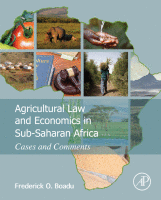Browse content
Table of contents
Actions for selected chapters
- Full text access
- Book chapterAbstract only
Chapter 1 - What Is Agricultural Law?
Pages 1-20 - Book chapterAbstract only
Chapter 2 - Contracts
Pages 21-93 - Book chapterAbstract only
Chapter 3 - Contract Farming
Pages 95-113 - Book chapterAbstract only
Chapter 4 - Agricultural Production and Share Contracts
Pages 115-140 - Book chapterAbstract only
Chapter 5 - Contracts Involving Illiterate Parties
Pages 141-184 - Book chapterAbstract only
Chapter 6 - Commercial Law
Pages 185-213 - Book chapterAbstract only
Chapter 7 - Trademarks and Patents
Pages 215-262 - Book chapterAbstract only
Chapter 8 - Cooperatives in Sub-Saharan Africa
Pages 263-281 - Book chapterAbstract only
Chapter 9 - Contracts Governed by International Conventions or Treaties
Pages 283-303 - Book chapterAbstract only
Chapter 10 - Tort Law
Pages 305-367 - Book chapterAbstract only
Chapter 11 - Eminent Domain
Pages 369-411 - Book chapterAbstract only
Chapter 12 - Forest Resources
Pages 413-445 - Book chapterAbstract only
Chapter 13 - Wildlife Resources
Pages 447-479 - Book chapterAbstract only
Chapter 14 - Water Resources
Pages 481-506 - Book chapterAbstract only
Chapter 15 - Environmental Law
Pages 507-536 - Book chapterAbstract only
Chapter 16 - Transboundary Water Resources and Wetlands
Pages 537-553 - Book chapterAbstract only
Chapter 17 - Climate Change
Pages 555-571 - Book chapterAbstract only
Chapter 18 - Food Safety Regulation
Pages 573-587 - Book chapterNo access
Index
Pages 589-603
About the book
Description
Agricultural Law in Sub-Saharan Africa: Cases and Comments introduces the subject of agricultural law and economics to researchers, practitioners, and students in common law countries in Sub-Saharan Africa, and presents information from the legal system in Botswana, Gambia, Ghana, Lesotho, Malawi, Nigeria, Sierra Leone, South Africa, Swaziland, Tanzania, Zambia, and Zimbabwe. The law and economics approach entails the use of quantitative methods in research. This is consistent with the expectations in an applied economics field such as agricultural economics.
Covering the general traditional law topics in contracts, torts, and property, the book goes further to introduce cutting-edge and region-relevant topics, including contracts with illiterate parties, contract farming, climate change, and transboundary water issues. The book is supported by an extensive list of reference materials, as well as study and enrichment exercises, to deepen readers’ understanding of the principles discussed in the book. It is a learning tool, first and foremost, and can be used as a stand-alone resource to teach the subject matter of agricultural law and economics to professionals new to the subject area as well as to students in law school, agricultural economics, economics, and inter-disciplinary classes.
Agricultural Law in Sub-Saharan Africa: Cases and Comments introduces the subject of agricultural law and economics to researchers, practitioners, and students in common law countries in Sub-Saharan Africa, and presents information from the legal system in Botswana, Gambia, Ghana, Lesotho, Malawi, Nigeria, Sierra Leone, South Africa, Swaziland, Tanzania, Zambia, and Zimbabwe. The law and economics approach entails the use of quantitative methods in research. This is consistent with the expectations in an applied economics field such as agricultural economics.
Covering the general traditional law topics in contracts, torts, and property, the book goes further to introduce cutting-edge and region-relevant topics, including contracts with illiterate parties, contract farming, climate change, and transboundary water issues. The book is supported by an extensive list of reference materials, as well as study and enrichment exercises, to deepen readers’ understanding of the principles discussed in the book. It is a learning tool, first and foremost, and can be used as a stand-alone resource to teach the subject matter of agricultural law and economics to professionals new to the subject area as well as to students in law school, agricultural economics, economics, and inter-disciplinary classes.
Key Features
- Offers research findings on such topics as food safety, climate change, transboundary natural resources, international sale of goods, patents, and trademarks to highlight the future sources of pressure on the agriculture industry
- Uses case-studies to provide real-world insights into the challenges and considerations of appropriate agricultural law development
- Challenges readers to carry out their own research in their areas of study, and to gain some understanding of the relationship between law, economics, and statistics
- Includes extensive resources, such as chapter summaries, study questions, and challenge questions at the end of each chapter to assist instructors and students in gaining full benefits from using the book
- Provides separate instructor and student study guides, a test bank, and test bank answers, in hardcopy and electronic formats
- Offers research findings on such topics as food safety, climate change, transboundary natural resources, international sale of goods, patents, and trademarks to highlight the future sources of pressure on the agriculture industry
- Uses case-studies to provide real-world insights into the challenges and considerations of appropriate agricultural law development
- Challenges readers to carry out their own research in their areas of study, and to gain some understanding of the relationship between law, economics, and statistics
- Includes extensive resources, such as chapter summaries, study questions, and challenge questions at the end of each chapter to assist instructors and students in gaining full benefits from using the book
- Provides separate instructor and student study guides, a test bank, and test bank answers, in hardcopy and electronic formats
Details
ISBN
978-0-12-801771-5
Language
English
Published
2016
Copyright
Copyright © 2016 Elsevier Inc. All rights reserved.
Imprint
Academic Press
